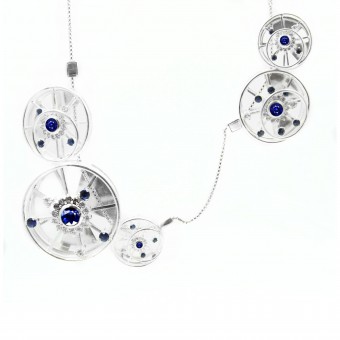DESIGN NAME:
The Cultural Heritage of Mo Hom Indigo
PRIMARY FUNCTION:
Kinetic Jewelry
INSPIRATION:
The people of Thung Hong District, Phrae Province (Thailand) Most of them are Tai Phuan people (Local tribe) who migrated to settle here. The identity of the Tai Phuan people in Thung Hong District is the Kamfa tradition as a heritage of society. that shows the wisdom of the Thai Puan ancestors that are hidden with the value of filial piety morale-building Solidarity among the group to have faith in the ritual of worshiping the sky is the center of the mind As a result, the Thai Puan people of Thung Hong have a strong culture. by the identity of the Tai Puan people, Thung Hong district has presented a culture of using wooden wheels from rickshaws to help in saving the labor of various occupations. Therefore, it is an important identity of the district and also has a wisdom that has been passed down for over 100 years, that is, making Hom (Indigo dyne powder that made from local plant call "HOM" ) is a reflection of the cultural beauty of Phrae's dress. Indicates an ethnicity with a history that has been inherited from ancestors for a long time. represents the uniqueness of the people of Phrae This can be seen from the traditional dress of the Phrae people. until it was said “Who came to Phrae? they have to buy clothes, pots and pans” until the present, Therefore, the tradition of using the wen wheel and the wisdom of making Hom combine in the design of jewelry, charming indigo earrings, indigo dying art in the area of Thung Hong
Therefore, the design of jewelry makes it uniquely beautiful in tradition. and important identity of Thung Hong Subdistrict By this ornament means strength. Patience and being creative in the art such as people in Thung Hong Subdistrict. By taking inspiration from Luo Wen and using the colors of Hom to design an ornament. Inspired by deconstruction and kinetic method. The concept of this jewelry is about using the idea and techniques of changing the original configuration, rotating the axis, or changing the position of the structure. Moreover, The movement of this jewelry was inspired by The traditional process of making Indigo dyne powder in Phrae Province Thailand.
UNIQUE PROPERTIES / PROJECT DESCRIPTION:
Inspired by deconstruction and kinetic method. The concept of this jewelry is about using idea and technique of changing the original configuration, rotating the axis or changing a position of the structure. It is challenging as well as breaks the rule of conventional perception. This jewelry has been designed by the kinetic system, to be able to move and adjust into multiple shapes or formations that are significantly different from each other. The imitation jewelry glass-ceramic materials were obtained from recycling waste gemstones. Based on the sintering glass-ceramics technique using metal powder as coloring agent to develop jewelry applications. The substantial viscous flow of the glass led to dense products for rapid treatments at relatively low temperatures (950 celsius), whereas glass/metal powder interactions resulted in the formation of color agent crystals, providing enhancement optical properties. Metallic powder peculiarity is the appearance of a colored metallic shine. There is a great potential for such materials with novel functionalities for artificial gemstone applications. The preliminary glass-ceramics tests were assessed by both physical and optical properties.
OPERATION / FLOW / INTERACTION:
The pendant can transform into many shapes that make it suitable in many situations. The wearer can change the shape of the pendant by pushing and pulling the pendant. Moreover, the pendant could be present as a mini sculpture that and uses for decoration.
The imitation jewelry glass-ceramic materials were obtained from recycling waste gemstones. which is a recycle material that could reduce the waste in jewelry-making production.
PROJECT DURATION AND LOCATION:
The project started in April 2020 in Bangkok Thailand and finished in April 2021, and was exhibited around Bangkok in 2021. The project has been developed from many of my kinetic jewelry projects from 2012-2021.
|
PRODUCTION / REALIZATION TECHNOLOGY:
Designed by a 3D program with high accuracy. About the prototype printed by 3D printer machine (Rapid prototype) at the micron level of accuracy, which allows the sophisticated parts and design. Every part is completely fit together, and could make a fluid movement. The Mechanical and joints that have been developed from the traditional jewelry making could make a difference in assembling process. The new joint and small part can be assembly together without using welding. This unique technic reduced the heating and save more energy from welding process, which is more friendly to the environment.
SPECIFICATIONS / TECHNICAL PROPERTIES:
Dimension: Width 200 mm x Depth 300 mm x Height 6 mm Weight: 30 grams Material: Silver, Glass ceramic
TAGS:
jewelry, kinetic, kinetic jewelry, Phrae Province, Thailand, HOM, Glass ceramic, Nitrogen plasma
RESEARCH ABSTRACT:
Kinetic and interaction are significant. Firstly, according to many research indicate that human eyes and attention have been developed to be attracted by a moving object. For example, we always attracted by moving people or object compare with nonmoving objects. Secondly, physical interaction is a part of human life. For example, we always use our hands to interact with something. For these reasons, I decided to combine Movement and interaction methods together in my jewelry to create a unique experience between the wearer and the jewelry.
CHALLENGE:
In order to create kinetic jewelry, I need to be completely understood in many kinetic aspects such as animal action and machine movable systems. I also need to transfer such a significant small piece of mechanism into my jewelry. In my point of view, my jewelry is an art piece that people could engage or play with it. for this reason, the wearer will feel completely connect with my jewelry.
ADDED DATE:
2021-06-30 17:25:24
TEAM MEMBERS (3) :
Duangkhae Bootkul, Namthip Tungkaewhong and Ketsiree Suksrikaew.
IMAGE CREDITS:
Image #1-3: Photographer Pasu Roungpanyaroj
|









